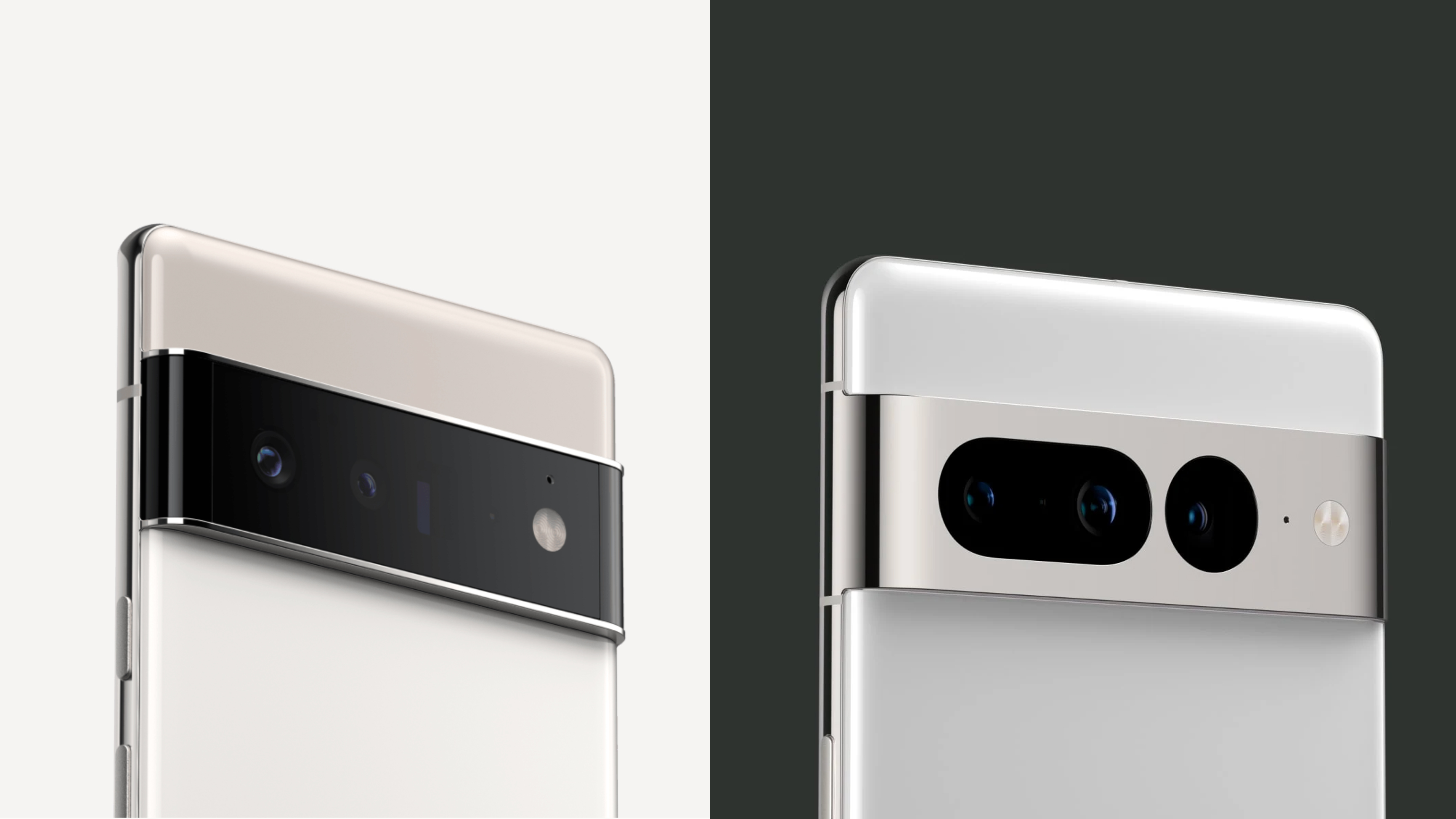Google Pixel 7 Pro vs 6 Pro: what's the difference?
Wondering exactly how the Pixel 7 Pro vs 6 Pro match up? Check out the main features and specs below

Google launched the Google Pixel 7 and Pixel 7 Pro smartphones in the fall of 2022. Here we will look at the flagship Pixel 7 Pro and compare it to its predecessor, the Google Pixel 6 Pro – which we awarded 5 stars in our review – to see how the Silicon Valley giant has improved the new model (or not).
The best Google Phones are loved for their ability to work seamlessly with other Google products, and they generally offer high-end features at a lower price than the best iPhones or Samsung phones – especially when it comes to photography. The "Pro" models in Google's smartphone lineup represent the very best tech, features, and design smarts, which also makes them the most expensive to buy.
Should you choose the slightly older Pixel 6 Pro, which will come down in price now it's been replaced by a new model? Let's take a look.
Google Pixel 7 Pro vs 6 Pro specs
What's the same?
The Pixel 7 Pro also has the same excellent display specs as its predecessor: a 6.7-inch display with a 120Hz refresh rate, although the new model does edge being better by offering a higher brightness at 1500nits. Both offer Gorilla Glass Victus protection, too.
Memory and storage remain unchanged too, with both smartphones having 12 GB of RAM and coming in 128GB, 256GB, and 512GB storage options.
What's changed?
While the Pixel 6 Pro runs on the first GEN Google tensor chip, the Pixel 7 Pro runs on Google’s next-generation Tensor chip, the Tensor G2, which offers of imaging and AI features we can’t wait to test, such as Photo Unblur and macro mode. The Tensor G2 also offers security and speech recognition improvements.
Both phones have the Titan M2 security chip, but the Pixel 7 Pro features built-in VPN powered by Google One (coming soon) and Face Unlock. The battery varies slightly, with the Pixel 6 Pro having a 5003mAh battery capacity and the Pixel 7 Pro having a 5000mAh capacity – both offer wired, wireless, and reverse wireless charging.
Google Pixel 7 Pro vs 6 Pro design
The Google Pixel 7 Pro looks very similar in design to its predecessor, including the prominent camera bar spanning the rear of the smartphone. There are some differences though: the Pixel 7 Pro doesn't have the same two-tone rear as the Pixel 6 Pro does and the camera housing has been changed to metallic, rather than glass so that the lenses stand out more as a result.
Size-wise, the two phones are almost identical, with the Pixel 7 Pro measuring 162.9 x 76.6 x 8.9mm and weighing 212g, compared to the Pixel 6 Pro at 163.9 x 75.9 x 8.9mm and 210g.
Like the Pixel 6 Pro, the Pixel 7 Pro is IP68 water and dust-resistant but color options differ. Google is offering the Pixel 7 Pro meanwhile in Snow, Obsidian, and Hazel, as opposed to the Pixel 6 Pro in Stormy Black, Cloudy White, and Sorta Sunny.


Google Pixel 7 Pro vs 6 Pro cameras

Main cameras
The Pixel 7 Pro has the same 50MP wide, 12MP ultra-wide, and 48MP telephoto lenses as the Pixel 6 Pro. There are differences in the triple rear camera system, though. As well as having 5x optical zoom over the Pixel 6 Pro’s 4x, the Pixel 7 Pro boasts 30x high-resolution zoom, compared to 20x on its predecessor. The 50 MP Octa PD Quad Bayer wide camera also has electronic image stabilization – using "computational photography" to sharpen shots.
Front camera
Strangely, while the Pixel 6 Pro has an 11.1MP sensor with f/2.2 aperture up front, the new Pixel 7 Pro only has a 10.8MP front camera with f/2.2 aperture selfie camera with the field of view reduced to 92.8 degrees, as opposed to 94 degrees on the Pixel 6 Pro.
Camera features
The majority of camera features are actually the same on the Google Pixel 7 Pro and Pixel 6 Pro: Night Sight, Top Shot, Portrait mode, Super Res Zoom, Motion auto-focus, Live HDR+, Frequent Faces, Dual exposure controls, Cinematic Pan, Ultrawide lens, Portrait Light, Magic Eraser14, Motion mode, Real Tone, Face Unblur, Panorama, Manual white balancing, and Locked Folder.
The only extra features that the Pixel 7 Pro has, in addition, are Photo Unblur and Macro Focus.
| Header Cell - Column 0 | Pixel 7 Pro | Pixel 6 Pro |
|---|---|---|
| Rear camera | 50 MP Octa PD Quad Bayer wide camera ƒ/1.85 aperture LDAF (laser detect auto-focus) sensor Optical and electronic image stabilisation 82° field of view 1.2 μm pixel width | 50 MP Octa PD Quad Bayer wide camera ƒ/1.85 aperture LDAF (laser detect auto-focus) sensor OIS (optical image stabilisation) on wide and telephoto 82° field of view 1.2 μm pixel width |
| Row 1 - Cell 0 | 12 MP ultrawide camera12 with auto-focus ƒ/2.2 aperture 125.8° field of view12 1.25 μm pixel width Lens correction | 12 MP ultrawide camera12 ƒ/2.2 aperture 114° field of view12 1.25 μm pixel width Lens correction |
| Row 2 - Cell 0 | 48 MP Quad Bayer PD telephoto camera ƒ/3.5 aperture 20.6° field of view 0.7 μm pixel width 5x optical zoom Super Res Zoom up to 30x | 48 MP telephoto camera ƒ/3.5 aperture 23.5° field of view 0.8 μm pixel width |
| Front camera | 10.8 MP ƒ/2.2 aperture Fixed focus 92.8° ultrawide field of view12 1.22 μm pixel width | 11.1 MP12 ƒ/2.2 aperture Fixed focus 94° ultrawide field of view 1.22 μm pixel width |
Google Pixel 7 Pro vs 6 Pro pricing
Pricing for the two models is currently the same with the Google Pixel 7 Pro starting at the same price as the Pixel 6 Pro started at in the US and the UK: £899 and $899. The release of this year’s model will inevitably force the price of the Pixel 6 Pro down (you can currently get one for around £100 / $100 less than the launch price) - but how much by remains to be seen.
Get the Digital Camera World Newsletter
The best camera deals, reviews, product advice, and unmissable photography news, direct to your inbox!
Rachael is a British journalist with 18 years experience in the publishing industry. Since working on www.digitalcameraworld.com, she’s been freelancing, and contributing to some of the world’s best-loved websites and magazines including T3.com and TechRadar.com and has also had a book, iPad for Photographers, published. She's currently acting as editor of 5GRadar.com - a website specializing in the latest cellular technology.

